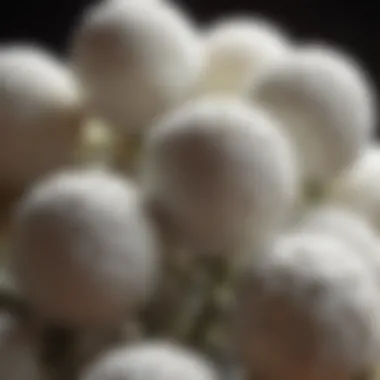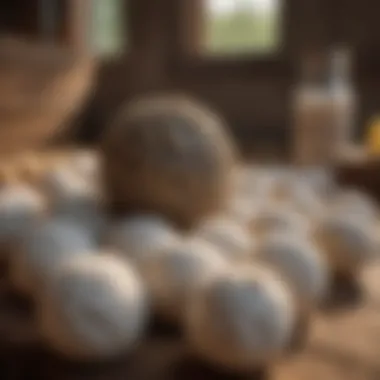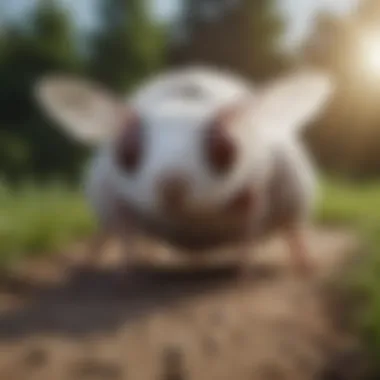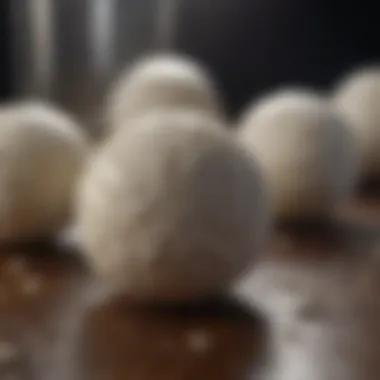Exploring the Multifaceted Uses of Mothballs


Intro
Mothballs have been a part of household pest control for many years. However, their utility goes beyond merely keeping pesky insects at bay. This article aims to shed light on the various aspects of mothballs, their chemical properties, modern-day applications, and safety measures to consider.
Agricultural practitioners and home gardeners may find that mothballs can serve multiple purposes, from odor control to preservation of stored goods. As we delve into this exploration, understanding the full impact and effectiveness of mothballs will be essential for informed application, especially when alternative pest control methods are becoming more prevalent.
As we continue, it is crucial to recognize the implications of using mothballs, balancing their benefits with potential risks. This examination will provide a clearer insight into not just traditional uses, but also newer trends that might influence their application in fields like agriculture and horticulture.
Preamble to Mothballs
Mothballs are small, solid spheres used primarily for pest control. They serve not only in homes but also in broader contexts such as agriculture and storage facilities. Understanding mothballs is essential because they encapsulate chemical properties, health implications, and historical applications that resonate across various domains. By diving deep into the subject of mothballs, we can uncover their multifaceted roles and the controversies that surround them.
Definition and Composition
Mothballs are usually composed of either naphthalene or paradichlorobenzene. Both of these compounds release vapors that insects find toxic. Naphthalene has a distinctive smell reminiscent of old clothes, while paradichlorobenzene lacks that strong odor but is still effective. These solid entities sublime at room temperature, allowing them to release gases that deter pests. Knowing what mothballs contain helps consumers make informed choices on their use, especially in food-sensitive environments.
Historical Context
The evolution of mothballs dates back to ancient times. They were originally made with natural substances like camphor, extracted from the wood of camphor trees. Over time, the chemical properties of mothballs were enhanced through synthetic production methods. This transition allowed for greater effectiveness against a variety of pests. By the late 19th century, commercial mothballs became widely accessible, gaining popularity among households and farmers alike. Understanding this historical context helps in appreciating how mothballs transitioned from a niche product to a household staple, and also highlights shifts in public perception regarding their usage and safety.
Primary Uses of Mothballs
The topic of Primary Uses of Mothballs serves as a critical focal point within this article. Understanding how mothballs function in various applications, especially in pest management, is essential for both agricultural practitioners and homeowners. Mothballs are often synonymous with pest control; however, their implications extend beyond mere extermination. The comprehension of these diverse functionalities aids users in making informed decisions about their application, ultimately improving effectiveness and minimizing risks associated with their use.
Pest Control in Agriculture
Mothballs have long been regarded as a viable option for pest control in agricultural settings. Farmers and growers frequently deploy mothballs to combat a range of agricultural pests that threaten crops. The primary active ingredient in mothballs, typically either naphthalene or paradichlorobenzene, functions as a potent repellent and insecticide.
In agriculture, mothballs are particularly useful in protecting stored grains and seeds from insects such as weevils and grain moths. The presence of mothballs mitigates pest infestation by producing a vapor that inhibits insect life, creating an environment less hospitable for pests. This preventative measure not only helps to preserve crop yield but also enhances the overall storage quality.
However, careful application is necessary. It is important to note that direct contact with crops can lead to contamination, raising concerns about chemical residues on produce.
Home Storage Applications
Mothballs are prominently used in home storage applications, especially for textiles, garments, and seasonal items. Many people opt for mothballs to protect wool and silk fabrics, which are prone to damage from moth larvae. The placement of mothballs in closets and storage bins acts as a barrier to moth infestations, thereby maintaining the integrity of valuable clothing items.
The efficiency of mothballs in such contexts is attributed to their evaporation properties. As they sublimate, they release their active ingredients into the air, creating an inhospitable atmosphere for moths and other fabric-damaging insects. This characteristic is invaluable in both residential and commercial storage situations.
Despite their advantages, furniture and clothing should not be directly exposed to mothballs. The strong odor can transfer to fabrics and items being stored, which may result in undesired scents or even damage.
Effectiveness Against Various Pests
The effectiveness of mothballs as a pest control agent varies significantly depending on the type of pest targeted. While mothballs are particularly effective against moths, their action extends to additional pests such as cockroaches and silverfish. Some users have reported success in deterring rodents as well, although this use can be considered more incidental.
It is crucial to recognize that mothballs do not eliminate pests; rather, they serve as a deterrent. Their unique vapor pressure can repel insects and rodents from treated areas. For maximum effectiveness, the placement of mothballs is essential. They should be positioned in enclosed spaces to allow for concentration of the vapors.
"Mothballs are not a catch-all solution but can be a helpful component in an integrated pest management strategy."
Utilizing mothballs in conjunction with other control methods improves the likelihood of successful pest management. It is advisable to regularly monitor treated areas for signs of pest activity, adapting application methods as necessary for sustained effectiveness.


In summary, the knowledge surrounding the primary uses of mothballs is not only relevant but essential for effectively using this chemical compound across various settings. With proper application and awareness of safety considerations, mothballs can prove to be a practical tool for pest control in both agriculture and home environments.
Chemical Properties of Mothballs
Understanding the chemical properties of mothballs is vital. This knowledge provides insights into their effectiveness, safety, and potential impacts on health and the environment. Mothballs primarily consist of chemicals such as naphthalene and paradichlorobenzene. Both compounds have distinct characteristics that influence their use in pest control and storage applications.
Active Ingredients and Their Functions
Naphthalene and paradichlorobenzene are the most common active ingredients in mothballs. Naphthalene is a polycyclic aromatic hydrocarbon. It sublimates at room temperature. This means it transforms from solid to gas without passing through a liquid state. This property is crucial for its function. As it evaporates, it creates a vapor that deters insects, specifically moths. Paradichlorobenzene, on the other hand, is a chlorinated aromatic hydrocarbon. It also sublimates at room temperature. However, its efficacy is slightly different due to its distinct chemical structure. Both compounds act as repellents, disrupting the insects' behavior and preventing infestation in stored textiles.
Volatilization and Temperature Effects
The process of volatilization greatly determines how effective mothballs will be in various environments. As temperature increases, the rate at which mothballs sublimates also increases. In warmer conditions, the release of chemical vapors becomes more significant, potentially leading to better pest control. Conversely, in cooler settings, the efficacy may decrease since fewer vapors are produced.
It is important to consider where mothballs are used. For instance, in an unheated attic, their effectiveness may diminish in winter months. An environment with fluctuating temperatures may impact how consistently mothballs repel insects. Maintaining the right conditions is thus imperative for optimal results.
"Understanding the chemical properties of mothballs highlights not only their uses but also the precautions needed for their effective application."
Finale
Safety Considerations
Understanding safety considerations surrounding mothballs is vital. Effective pest control often comes at the cost of potential health and environmental hazards. Mothballs release volatile compounds that can pose risks to both humans and animals. Therefore, it is crucial to recognize these elements to ensure responsible usage and mitigate adverse effects.
Health Risks Associated with Mothballs
Mothballs predominantly contain either naphthalene or 1,4-dichlorobenzene. Both of these chemicals can lead to a range of health issues if inhaled or ingested. Exposure can occur through direct contact with mothballs, inhalation of vapors, or handling garments that have been stored with mothballs.
Common health risks include:
- Respiratory problems: Inhaling vapors may irritate lungs, causing coughing or difficulty breathing.
- Skin irritation: Direct contact can lead to rashes or allergic reactions.
- Neurological issues: High levels of exposure can impact the nervous system, potentially leading to headaches, confusion, or dizziness.
- Liver and kidney damage: Over time, accumulation in the body can affect these organs' function.
Vigilance is essential while using mothballs, especially in poorly ventilated spaces. Following manufacturer guidelines and using protective equipment can help minimize these health risks.
Environmental Impact
The environmental impact of mothballs is significant and multifaceted. Their active ingredients can contaminate soil and water. When mothballs evaporate, their chemicals enter the air and ecosystem, where they can affect wildlife and vegetation.
Key environmental concerns include:
- Toxicity to wildlife: Animals may ingest mothballs or inhale vapors, leading to acute poisoning or long-term health complications.
- Soil contamination: Used mothballs can leach harmful substances, altering soil composition and affecting plant growth.
- Waterway pollution: Runoff may carry chemical residues into water systems, risking aquatic life.
The use of mothballs can, therefore, pose risks that extend beyond immediate pest control. Selecting alternatives that are less harmful to the environment may be prudent. Recognizing these impacts fosters a more informed approach towards pest management in agriculture and home settings.
Legal and Regulatory Aspects
Understanding the legal and regulatory aspects surrounding mothball use is essential for various stakeholders, including farmers, home gardeners, and those in storage business. Mothballs can pose health and environmental risks, which necessitates oversight to ensure safe usage. Regulations serve both to protect consumers and to guide manufacturers in producing safe products. This section emphasizes the importance of being aware of the existing laws and guidelines that govern mothball applications. It ensures responsible usage and provides insights into best practices.
Regulations Governing Mothball Use


Mothballs fall under specific regulations that vary by jurisdiction. In the United States, for example, the Environmental Protection Agency (EPA) regulates mothballs as pesticides. This classification mandates that products containing naphthalene or paradichlorobenzene must adhere to strict safety and environmental standards.
Key regulations include:
- Registration Requirements: Manufacturers must register their products with the EPA, providing data on safety and efficacy.
- Usage Instructions: Labeling requirements are in place to inform users of correct application methods, safety precautions, and potential health risks.
- Legal Limits: Certain concentrations of active ingredients are restricted in residential areas to limit exposure.
Failure to comply with these regulations may result in penalties for manufacturers and increased risk for users, making it vital to stay informed about the laws applicable to mothball usage.
Labeling and Consumer Awareness
Effective labeling is crucial in guiding consumers on the safe use of mothballs. The information provided on packaging reflects regulatory standards and serves as a resource for safe practices. For example, labels must include:
- Active Ingredients: Clear listing of the chemicals present in the product.
- Safety Information: Warnings about potential health risks, especially for vulnerable groups such as children and pets.
- Usage Directions: Specific instructions on how to apply the product without causing harm.
Consumer awareness plays a significant role in ensuring safety. Understanding the implications of the information on the label can prevent misuse and accidental exposure. It is imperative that users read and understand labels and guidelines thoroughly before using mothballs to mitigate risks associated with incorrect application.
Alternative Methods of Pest Control
When considering pest control, it is crucial to evaluate alternatives to traditional methods like mothballs. These alternatives can offer effective solutions while addressing safety and environmental concerns. By exploring various options, users can choose strategies that align with their values and specific pest problems. Since the reliance on chemical treatments can sometimes lead to negative consequences, examining natural and chemical alternatives presents a significant opportunity for better pest management.
Natural Alternatives
Natural pest control approaches focus on utilizing eco-friendly options that are generally safer for both humans and the environment. There are several methods that farmers and enthusiasts can explore:
- Essential Oils: Many essential oils, such as lavender, peppermint, and eucalyptus, exhibit strong repellent properties. Spraying diluted versions of these oils can deter pests effectively without harmful chemicals.
- Diatomaceous Earth: This natural powder consists of the fossilized remains of diatoms. It acts as a desiccant, damaging the exoskeletal structures of insects upon contact. This method is ideal for controlling a range of pests, including ants and cockroaches.
- Beneficial Insects: Introducing predators like ladybugs and lacewings can help keep pest numbers in check. This biological control method encourages a healthy ecosystem on farms and gardens.
- Companion Planting: Certain plants can naturally repel pests. For instance, marigolds are known to deter nematodes, while basil protects tomatoes from flies.
Natural alternatives not only tend to be less harmful but also encourage a sustainable approach to pest management. However, understanding the specific pests to target is vital to ensure effectiveness.
Chemical Alternatives
For those who might prefer or require chemical alternatives, it is important to select safer, more regulated products that minimize risk. Here are some options:
- Insecticidal Soaps: These products contain natural fats and oils, effectively killing soft-bodied insects upon contact. They work by suffocating the pests and are safe for plants when used as instructed.
- Pyrethroids: These are synthetic versions of naturally occurring insecticides derived from chrysanthemum flowers. They offer quick knockdown of insects but should be used with caution due to potential toxicity to aquatic life.
- Boric Acid: Commonly used in pest control, boric acid disrupts an insect's digestive system and can be effective against cockroaches and ants. Care should be taken to avoid human and pet exposure.
Key Consideration: While chemical alternatives may offer quick results, it is essential to consider their impact on the environment and human health. Proper application techniques must be followed to minimize these risks.
Choosing the right pest control method involves weighing the pros and cons of natural and chemical alternatives. Understanding these options not only aids in effective pest management but also promotes a more sustainable approach.
Practical Application of Mothballs
The application of mothballs is often relegated to discussions around pest control. However, their relevance extends far beyond simple deterrence of moths. Understanding the myriad practical applications of mothballs is essential for agricultural practitioners and home gardeners alike. Their distinct chemical properties, combined with historical usage patterns, make them valuable in various settings. This section explores how mothballs are effectively employed, the benefits they provide, and important considerations that come with their usage.
Mothball Use in Clothing and Fabrics
Mothballs are widely recognized for their role in protecting clothing and fabrics from pests. The active ingredients, such as naphthalene and paradichlorobenzene, repel not only moths but also other insects that might damage textiles. This use is especially pertinent in regions where natural predators of moths are scarce.
- Protection for Long-Term Storage: When clothing is stored for an extended period, such as seasonal changes, mothballs can provide a critical line of defense. This is particularly important for delicate fabrics like silk or wool, which are more vulnerable to insect damage.
- Ease of Use: Placing mothballs in storage containers, garment bags, or closets is a straightforward method to deter pests. They require minimal maintenance, making them an appealing choice for busy households.
However, there are some precautions to take when using mothballs around clothing. First, it is essential to ensure that clothing is properly ventilated, as excessive exposure to mothballs may result in lingering odors. Secondly, proper usage according to the manufacturer's guidelines cannot be overstated, as improper use may lead to health risks.


Utilization in Storage Facilities
The application of mothballs in storage facilities serves a broader range of purposes, particularly in agricultural settings. Many farmers and storage managers use mothballs to protect grain, seeds, and other supplies from pests during storage.
- Pest Deterrent in Bulk Storage: For facilities storing large quantities of grains or seeds, mothballs can help mitigate the risk of infestations. This is crucial in areas where moisture and temperature could promote pest attraction and breeding.
- Cost-Effectiveness: Employing mothballs as a pest control strategy in storage facilities is often more affordable than alternative methods, such as professional pest control services. Regular use ensures that pest populations do not grow unchecked, saving both time and resources.
Despite these benefits, the use of mothballs in storage facilities raises potential environmental concerns. The vapor from mothballs can affect air quality within storage spaces, and proper ventilation is necessary. Additionally, it is crucial to consider how these substances might interact with stored products, taking care to assess any risks prior to application.
In summary, mothballs serve important roles both in clothing storage and agricultural storage facilities. While their effectiveness is well-documented, understanding both the benefits and risks is key to utilizing them safely and effectively.
Mothballs in Cultural Context
The cultural significance of mothballs extends beyond their practical use in pest control. They symbolize a deeper connection between humans and their environment, often meant to preserve cherished belongings. While the primary purpose of mothballs is to protect fabrics and materials, the perceptions surrounding them are shaped by folklore, myths, and evolving practices across diverse societies.
Cultural Perceptions and Myths
Mothballs have been surrounded by various myths and cultural perceptions. In many households, they are perceived almost as a necessity for preserving connections to past generations. Some individuals have superstitions about mothballs bringing good luck. On the other hand, the negative aspects associated with health risks have led to a dual perception. Some people see them as harmful, while others trust their efficacy without understanding the risks.
In different cultures, mothballs are often linked to certain rituals. For example, in some regions, they are used in clothing storage as a sign of respect for fabric and heritage. This association can magnify their significance beyond mere utility. Traditionally, mothballs served important roles in family customs, where their use was believed to protect treasured items, thus reinforcing familial bonds.
The way people perceive mothballs can influence their usage and even their emotional connection to the objects being preserved.
Evolution of Usage Over Time
Over the years, the use of mothballs has evolved significantly. Initially, their introduction was purely functional. Farmers relied on them for storage of grains and textiles, as these substances contained active ingredients that repelled pests effectively. As times changed, so did the approach to storage practices.
In contemporary settings, especially among younger generations, mothballs are less likely to be seen as the go-to solution for pest control. Many now opt for alternatives that align with environmental sustainability. However, this shift does not erase the historical importance mothballs hold within many cultures. Their usage has peaked and trough based on scientific discoveries and the increasing awareness surrounding health impacts.
As urbanization increases, so does the use of mothballs. Urban dwellers often resort to them for storing clothing and linens in less ventilated spaces. This reflects a common trend where more people encounter traditional practices in modern contexts. Interestingly, while the product evolves, the mythos surrounding it often remains intact, creating a complex relationship between tradition and modernity.
In summary, the cultural context of mothballs offers an insightful look into how these simple products connect human behavior, tradition, and values spanning generations. Understanding this context enhances our appreciation of what mothballs represent, beyond their functional role.
Epilogue and Future Considerations
The exploration of mothballs reveals a complex array of uses that extend beyond simple pest control. This article highlights the multifaceted applications of mothballs, ranging from home storage to agricultural settings. Understanding these uses is essential not just for informed decisions among agricultural practitioners, but also for consumers looking to utilize mothballs effectively while being cautious of their potential risks.
One key element discussed is the chemical composition of mothballs and its implications for both effectiveness and safety. It is crucial to acknowledge that while mothballs can provide benefits, their toxic nature also mandates careful handling. Furthermore, exploring cultural perceptions around mothballs guides us to reflect on evolving attitudes towards their usage in diverse contexts.
Future considerations should focus on enhancing regulations surrounding mothball usage, ensuring consumer safety while maximizing efficacy.
"The balance between utilizing mothballs effectively and ensuring safety is delicate and requires careful consideration."
As professionals and researchers delve deeper into this topic, a thrust towards safer alternatives and sustainable practices would benefit not only agricultural sectors but also provide consumers with more options.
Summary of Key Points
Several points emerged as central to the understanding of mothballs:
- Chemical Composition: Mothballs primarily contain naphthalene or paradichlorobenzene, both linked to health hazards.
- Applications Beyond Pest Control: From clothing preservation to aiding in agriculture, their utility is diverse.
- Safety Considerations: Health risks are present, particularly concerning inhalation and skin exposure.
- Regulatory Compliance: Awareness about legal frameworks can facilitate safer usage.
- Alternative Solutions: Understanding other pest control methods will support more sustainable practices.
Implications for Future Research
Future research should focus on several areas to enhance the understanding of mothballs and their applications:
- Detailed Toxicological Studies: Further investigations into the health impacts of prolonged exposure to mothballs are necessary.
- Consumer Awareness Programs: Educating the public about proper usage and potential risks could prevent misuse.
- Development of Safer Alternatives: Researching organic and less toxic substances that can serve as replacements for mothballs presents a valuable opportunity.
- Evaluation of Environmental Impact: The long-term ecological effects of mothball usage, particularly in agricultural settings, require deeper analysis.
- Cultural Studies: Exploring how different cultures view and use mothballs can provide insight into varying practices and beliefs.
In closing, while mothballs remain a useful tool, a deeper understanding of their implications and effects is crucial for responsible use and future innovations.



